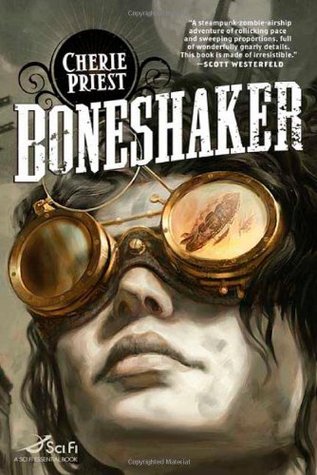Today I'm looking at the first book in a series of steampunk books by Cherie Priest, Boneshaker, which I've heard is her most famous novel. At least to the point within the steampunk community that Boneshaker is often remembered as her fist novel when Priest had actually written other books prior to this one. (This is at least what Priest said anyway.) Overall I'd say this book is okay, but it leaves me with a lot of questions, at least one of which I think needs a serious answer.
The book is set in an alternate history United States about 1876 or so. Right before the American Civil War began, gold was discovered in Russian Alaska and the Klondike Gold Rush began. Seattle, located on the western coast and an ideal launching point for prospectors, boomed with the growth of the gold trade in the Klondike. Until the incident with the Boneshaker.
See, the biggest problem was most of the gold in the Klondike was inaccessible to miners. (Have you read a Jack London story? Don't, the lesson is Alaska is a dangerous place and will kill you.) So the Russian government held a contest for the design of a machine to make mining the goldfields practicable. The winning submission was presented by Dr. Levi Blue of Seattle who at the behest of the Russians launched a test of his Boneshaker Drill. The result of the test was a significant portion of downtown Seattle was destroyed and a source of deadly Blight Gas, which kills everyone and turns some of those exposed to it into zombies, made the city uninhabitable. The residents of Seattle responded by building a wall two hundred feet high around the old city, containing the Blight and the shambling monsters.
Our main characters are Briar Wilks, widow of the late, unlamented Dr. Blue, and her son Ezekiel. Zeke is convinced that all rumors that his father's use of the Boneshaker was intentional are false, and is determined to prove that what happened to render Seattle uninhabitable was an accident. To do this, Zeke goes under the wall into old Seattle searching for scraps of evidence left behind. Briar knows that inside the wall is a deadly place that her sixteen year old son can't hope to survive, so she goes in to rescue her son herself.
Plot wise, I don't know if I really enjoyed this story. Despite the setting, it felt like a ''two characters trying to find each other'' sort of story, with at least a few incidents where the characters paths potentially could cross but don't until we get to the climax of the story. I mean, it's good that Briar is looking to rescue her darn kid from his stupid and potentially deadly situation, but for whatever reason I couldn't find myself getting emotionally invested in them as characters.
I will leave aside, for the time being, the question as to how the Civil War has been going on for about sixteen years. It's at least implied within the book that there are at least a few reasons why the war could be extended as long, including airships, a southern railroad, and British intervention. At this point I will forego my usual historian rant about the larger economic, social, and political factors which make such an outcome unlikely to say the least.
My biggest question for this book is why the heck people still live in Seattle anymore. The survivors create a settlement outside the wall called Outskirts, and there's still some trading activity, but it was stated that most of the trade has dried up when the most accessible of the gold was depleted in the Klondike rush. Now, cities have grown up around booms and then continued having grown into viable communities, but mining rushes have also produced numerous ghost towns that dot the American West. With the town infrastructure and the trade gone, I'm not sure why people would stay in Seattle. I mean, they have to boil all of their water because Blight Gas still escapes the Wall and even rainwater can't be trusted to be potable, which sounds like it's better to just abandon the place entirely than keep trying. Maybe the amount of trade was bigger than I gleaned from the book, Briar does visit an airship port, but I'm not certain.
The only real resource of note anymore is the Blight itself, which is useful for creating a drug referred to as lemonsap, but that's about it. And most of the Blight collected and processed for lemonsap is done by criminal organizations operating inside the wall. So why anybody would continue to live outside is puzzling to me.
Otherwise the book is okay. I have reason to hope that the later books would build on the foundation and maybe go to more interesting places and more interesting adventures. But because I didn't really emotionally connect with either Briar or Zeke I couldn't get as invested in their personal story as Priest might hope.
- Kalpar


No comments:
Post a Comment